[ad_1]
The chest dip is an upper-body exercise that involves lowering your body between two “dip bars” and pressing yourself upward again.
It trains all of your upper-body pushing muscles to a high degree and allows you to lift heavy weights safely, which means it’s ideal for gaining muscle and strength.
That said, many people avoid the chest dip because they’ve heard dip exercises are bad for their shoulders.
As long as you perform the chest dip with proper form, shoulder issues shouldn’t be a bother. In fact, many people find that the neutral grip that you use in the dip is kinder to their shoulders than pressing with a barbell.
In this article, you’ll learn what the chest dip is, its benefits, which muscles it works, how to do a chest dip with proper form, the best chest dip workout and chest dip alternatives, and more.
What Is a Chest Dip?
The chest dip (often referred to as the parallel-bar dip, straight-bar dip, or usually just the dip) is an upper-body exercise that involves holding two horizontal bars, supporting your body weight on your arms, lowering your body between the bars by bending at the elbow, then pressing yourself upward until your arms are straight.
You can perform the chest dip using any parallel bars, provided they’re strong enough to support your body weight and high enough to allow you to “dip” between them without touching your feet on the floor. However, most people prefer to use a dip bar station—a sturdy metal frame with parallel bars so you can perform the dip, a pull-up bar for pull-ups, and armrests and a back pad to do the captain’s chair leg raise.
Chest Dip vs. Triceps Dip
The chest dip and triceps dip are almost identical dip exercises. The only difference is how you tilt your upper body and flare your elbows.
In the chest dip, you lean slightly forward and allow your elbows to flare at a 30-to-60-degree angle relative to your torso, which emphasizes your pecs marginally more than your triceps.
In the triceps dip, you keep your torso upright and elbows close to your sides, which trains your triceps slightly more than your pecs.
Many claim these minor differences make the exercises distinct and separate, but I disagree; both variations train the same muscle to a similar degree. The primary reason to do one over the other is comfort.
For example, some people find leaning forward during the dip causes pain in their sternum. If this is the case for you, you’re probably better suited to the triceps dip.
Other people find staying upright mauls their shoulders. If you experience this during the triceps dip, the chest dip is probably more fitting.
Therefore, instead of thinking in terms of chest vs. triceps dip, it’s better to think in terms of chest or triceps dip, depending on your preferences and circumstances.
(And if you’d like even more specific advice about what exercises to include in your training program to reach your health and fitness goals, take the Legion Strength Training Quiz, and in less than a minute, you’ll know the perfect strength training program for you. Click here to check it out.)
Chest Dip: Benefits
1. It trains several major (and many minor) muscle groups.
Studies show that the chest dip trains all of your upper body “pushing” muscles, including the sternocostal (“lower”) and clavicular (“upper”) heads of the pecs; the lateral, medial, and long head of the triceps; and the shoulders, particularly the anterior (front) delt.
Unlike most compound chest exercises, the dip is also a closed-kinetic-chain exercise—an exercise where your hands or feet are fixed on a stationary object. In the case of the dip, your hands are fixed to the bars, whereas in the bench press, for example, a bench supports your back so you can move your hands and feet freely.
One of the benefits of closed-kinetic-chain exercises is that they require more balance and stability than open-chain-kinetic exercises, which means they train “stabilizer” muscles across your entire body to a higher degree.
2. It’s highly scalable.
It takes a lot of strength to lower your entire body weight between two bars and press yourself back up again, which is why the full bodyweight chest dip isn’t always the best place to start for beginner weightlifters.
Fortunately, there are exercises you can perform, such as the bench dip, machine chest dip, and assisted chest dip, that help you build the strength you need to progress to the regular dip.
Once you have the strength to do several reps (usually 10-to-15) of the bodyweight dip without resting, you can also make the exercise more challenging by snatching a dumbbell between your thighs or strapping a weight plate around your waist using a dip belt (also known as the weighted chest dip).
In other words, the chest dip is highly scalable. That is, regardless of how strong you are, there’s a chest dip alternative that’ll suit your experience and strength level and challenge you to get stronger over time.
3. It may be easier on your shoulders.
Unlike many other compound pressing exercises, such as the bench press and incline bench press, the dip involves a neutral (palms facing each other) grip. Using a neutral grip keeps your forearms and upper arms aligned, which places less stress on your shoulders.
This makes it ideal for people who are training around a shoulder injury or who find barbell pressing exercises uncomfortable.
Chest Dip: Muscles Worked
The main muscles worked by the chest dip are the pecs, triceps, and anterior deltoids.
Here’s how those muscles look on your body:
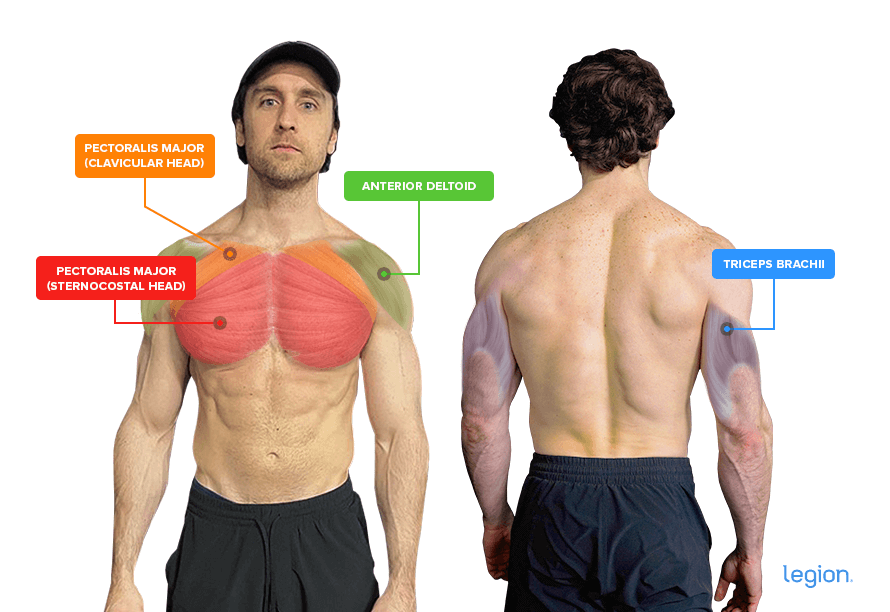
Chest Dip: Form
The best way to learn how to do a chest dip is to split the exercise into three parts: set up, dip, and ascend.
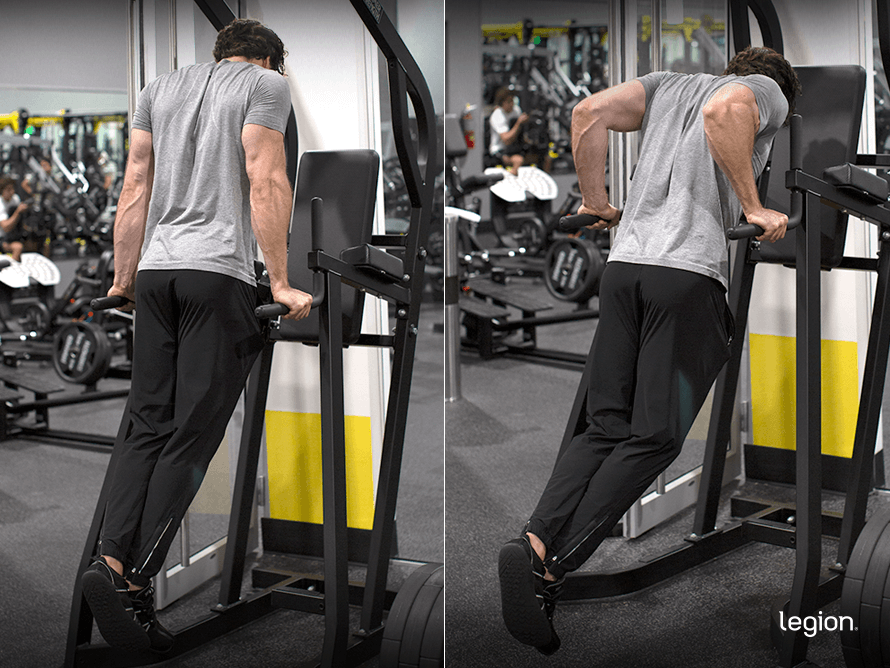
1. Set Up
Grab both handles of a dip bar station, then press yourself upward by straightening your arms and gently jumping off the ground so that your arms are straight and supporting your entire body weight with your hands underneath your shoulders.
Without bending your elbows, tuck your shoulder blades down and squeeze them together. A good cue for this is to imagine moving your shoulders toward the floor, away from your ears, and pinching a pencil between your shoulder blades.
Lean forward slightly, then bend your knees and cross your feet over each other behind you if you find it more comfortable.
2. Dip
Lower your body by bending your elbows, allowing your elbows to flare about 6-to-8 inches from your sides, until your arms are at a 90-degree angle.
Don’t roll your shoulders forward or allow your shoulder blades to shift apart or upward.
3. Ascend
Press upward and return to the starting position. This is a mirror image of what you did during the dip.
Don’t allow your shoulders to “shrug” or try to straighten your arms slowly. The entire “ascension” should be controlled but only take about a second.
Here’s how it should look when you put it all together:
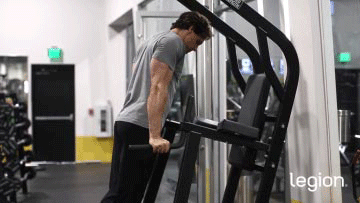
The Best Chest Dip Alternatives
1. Bench Dip

The bench dip involves lowering your body over the side of a bench until your arms are at a 90-degree angle and pressing yourself back up again.
If you’re completely new to weightlifting and can’t perform a single chest dip with good form, the bench dip helps you strengthen the muscle you need to perform the regular dip with proper form.
That said, the bench dip can be dangerous for your shoulders if you perform it incorrectly. To avoid this, keep your shoulder blades back and down throughout each rep and never let your shoulders roll forward at the bottom of each rep.
When the regular bench dip becomes too easy, some people also like to lay weight plates in their lap and perform a weighted bench dip. However, I don’t recommend this because it’s difficult to set up and unload, and if your form isn’t perfect, it can increase your risk of shoulder injury.
2. Machine Chest Dip
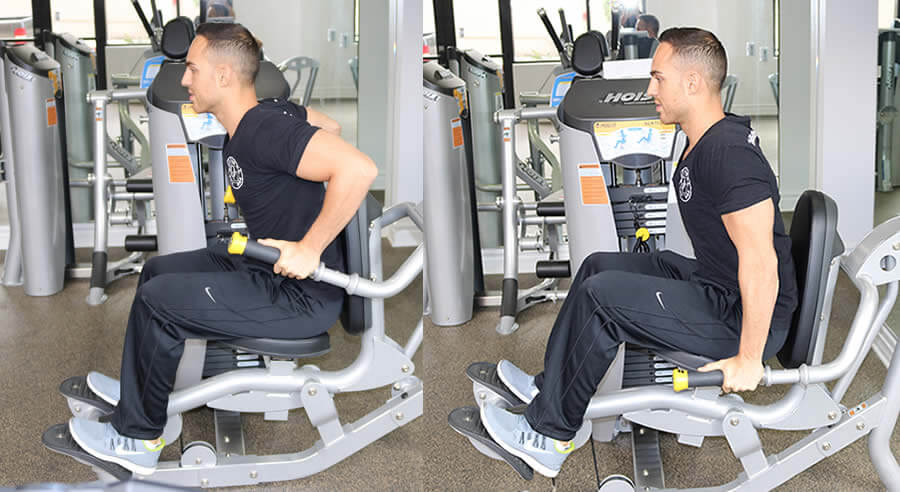
The machine chest dip is a chest dip alternative that uses a chest dip machine to mimic the movement of the dip exercise without your body leaving the floor. You can use the machine chest dip for chest, triceps, and shoulder training, so that you build the strength you need to perform the regular chest dip.
Machine exercises are slightly less effective than free-weight exercises for gaining muscle and strength, though, which means any strength you build on the machine chest dip probably won’t translate to the bodyweight version perfectly.
3. Assisted Chest Dip
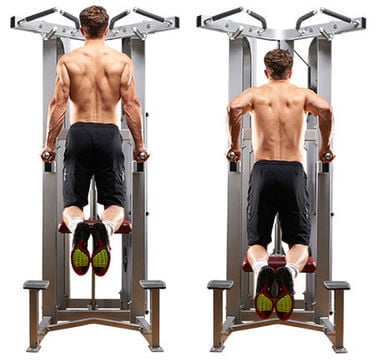
The assisted chest dip is a chest dip exercise involving an assisted chest dip machine. An assisted chest dip machine supports some of your body weight as you perform the chest dip, effectively making your body lighter and the exercise easier to perform.
The benefits of the assisted chest dip are that it allows you to train the chest dip through a full range of motion even when you don’t have the strength to perform it with your body weight, helping you develop the strength you need to perform the exercise unaided.
4. Weighted Chest Dip
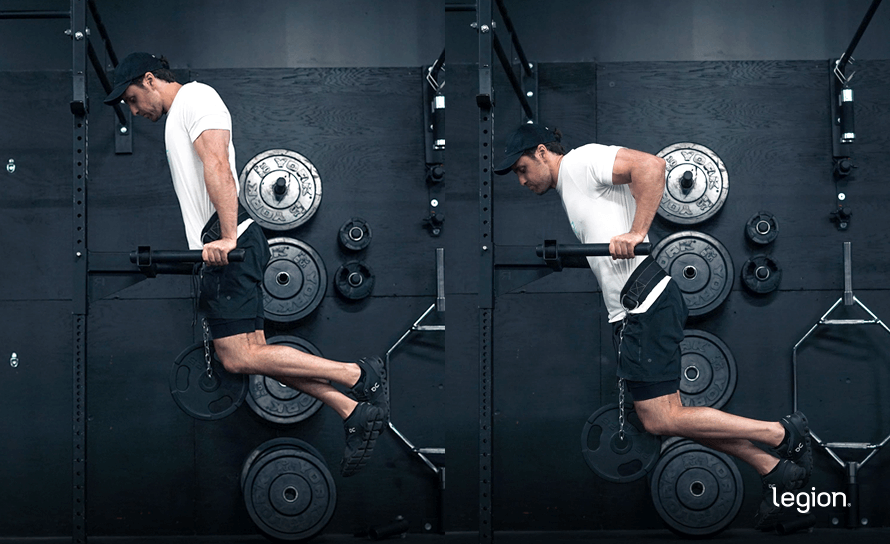
In the weighted chest dip, you snatch a dumbbell between your thighs or strap a weight around your waist. This allows you to progressively overload the chest dip when the bodyweight chest dip becomes too easy.
5. Ring Dip
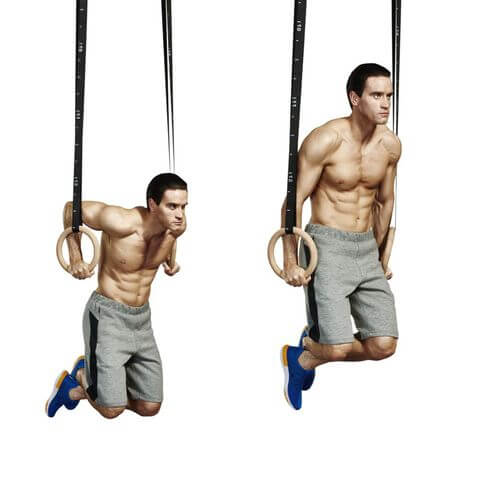
Ring dips are chest dips using gymnastic rings instead of a dip bar station. Ring dips are more challenging than regular bodyweight chest dips because rings are unstable, which means your muscles have to work harder to stabilize your body. This makes them a viable dip alternative once regular bodyweight chest dips become too easy.
The strength of the ring dip is its biggest drawback, though. That is, its inherent instability means it’s difficult to add extra weight to the exercise over time, which limits its muscle- and strength-building potential.
The Best Chest Dip Workout
If you want to maximize muscle growth, research shows that it’s best to train your muscles in different ways, from different directions, and at different angles.
To accomplish this, include other chest exercises in your chest dip workout, like this:
Bench Press: 3 sets of 4-to-6 reps with 2-to-3 min rest*
Chest Dip: 3 sets of 4-to-6 reps with 2-to-3 min rest
Incline Dumbbell Bench Press: 3 sets of 6-to-8 reps with 2-to-3 min rest
Triceps Pushdown: 3 sets of 6-to-8 reps with 2-to-3 min rest
* It’s ideal to bench press first as it’s the most technically challenging and fatiguing.
FAQ #1: Are dips better than push-ups?
It depends.
The dip and push-up are both effective exercises that train the same muscles. The main benefits of the dip are that it trains your muscles through a longer range of motion and in a more stretched position, and it allows you to add extra weight easily, both of which are important for gaining muscle and strength.
On the other hand, the push-up is easy to learn and can be performed anywhere without gym equipment, making it ideal for people new to weightlifting or who don’t have access to a gym.
FAQ #2: Is there a difference between the regular chest dip and the lower chest dip?
No.
Some people say that you can emphasize the lower part of your chest by staying slightly more upright and exaggerating your elbow flare in the chest dip. This isn’t based on any scientific evidence, though, and may put your shoulders in a compromised position, so I don’t recommend you try it.
FAQ #3: What’s the best dip bar station for a home gym?
If your budget and workout space permit, a “power tower” is a good option because it’ll allow you to perform several exercises, including the chest dip, triceps dip, chin-up, pull-up, and captain’s chair leg raise.
The Weider Power Tower is simple, sturdy, and strong (it can hold up to 300 pounds), which makes it ideal for any home gym.
If you already have a power rack, you may prefer to get a dip bar attachment, which is a dip bar that attaches to one of the upright posts on your power rack.
If you decide to get a dip bar attachment, make sure you choose one that’s compatible with your rack.
+ Scientific References
- Bagchi, A. (n.d.). (PDF) A COMPARATIVE ELECTROMYOGRAPHICAL INVESTIGATION OF TRICEPS BRACHII AND PECTORALIS MAJOR DURING FOUR DIFFERENT FREEHAND EXERCISES. Retrieved July 27, 2022, from https://www.researchgate.net/publication/331477905_A_COMPARATIVE_ELECTROMYOGRAPHICAL_INVESTIGATION_OF_TRICEPS_BRACHII_AND_PECTORALIS_MAJOR_DURING_FOUR_DIFFERENT_FREEHAND_EXERCISES
- Schanke, W., Porcari, J. P., Felix, E., Hendrix, C., & Foster, C. (n.d.). Top 3 MosT EffEcTivE chEsT ExErcisEs ACE-SponSorEd rESEArCh. Retrieved July 27, 2022, from https://acewebcontent.azureedge.net/certifiednews/images/article/pdfs/ACE_BestChestExercises.pdf
- Kwon, Y. J., Park, S. J., Jefferson, J., & Kim, K. (2013). The Effect of Open and Closed Kinetic Chain Exercises on Dynamic Balance Ability of Normal Healthy Adults. Journal of Physical Therapy Science, 25(6), 671. https://doi.org/10.1589/JPTS.25.671
- Escalante, G. (2017). Exercise Modification Strategies to Prevent and Train Around Shoulder Pain. Strength and Conditioning Journal, 39(3), 74–86. https://doi.org/10.1519/SSC.0000000000000259
- Barakat, C., Barroso, R., Alvarez, M., Rauch, J., Miller, N., Bou-Sliman, A., & De Souza, E. O. (2019). The Effects of Varying Glenohumeral Joint Angle on Acute Volume Load, Muscle Activation, Swelling, and Echo-Intensity on the Biceps Brachii in Resistance-Trained Individuals. Sports (Basel, Switzerland), 7(9). https://doi.org/10.3390/SPORTS7090204
- Schoenfeld, B. J., & Grgic, J. (2020). Effects of range of motion on muscle development during resistance training interventions: A systematic review. SAGE Open Medicine, 8, 205031212090155. https://doi.org/10.1177/2050312120901559
- Oranchuk, D. J., Storey, A. G., Nelson, A. R., & Cronin, J. B. (2019). Isometric training and long-term adaptations: Effects of muscle length, intensity, and intent: A systematic review. Scandinavian Journal of Medicine & Science in Sports, 29(4), 484–503. https://doi.org/10.1111/SMS.13375
[ad_2]
Source link

